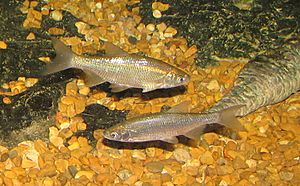Striped shiner facts for kids
Quick facts for kids Striped shiner |
|
|---|---|
 |
|
| Conservation status | |
| Scientific classification | |
| Synonyms | |
|
Notropis chrysocephalus (Rafinesque, 1820) |
The striped shiner (Luxilus chrysocephalus) is a cool freshwater fish. It belongs to the Cyprinidae family, which includes many types of minnows. This fish is silvery and has three or four stripes along its back and sides. It also has dark crescent shapes on its body.
Its scales and tiny sensory pores on its snout can have black outlines. The fins are usually clear or a milky white. Its tail fin has a milky base with a black or gray spot. Male striped shiners can have pink snouts and patches of red or pink on their bodies. These fish have large mouths at the very end of their heads. They can grow to be about nine inches long.
Contents
What Do Striped Shiners Eat?
Striped shiners eat many different things. They mostly feed on insects that live in the water, like termites, mayflies, dragonflies, caddisflies, beetles, and tiny midges. They also eat things found on the bottom of rivers, such as algae. These fish eat all day and night. However, they tend to eat more from the bottom at night.
Where Do Striped Shiners Live?
You can find striped shiners in the middle and upper parts of streams and rivers. They also like rocky pools in both clear and cloudy creeks.
Where Are Striped Shiners Found?
These fish live in many places across North America. They are found in rivers that flow into the Gulf Coast, from Texas all the way to Alabama. You can also find them further north in Tennessee. Striped shiners also live in the Great Lakes region, including parts of New York and Wisconsin.
Reproduction and Life Cycle
Striped shiners usually breed from March to July. Sometimes, their breeding season can even last until October. During this time, both male and female fish change color from silver to a shiny gold. All their fins, except for their tail, turn orange.
They lay their eggs in shallow water over gravelly stream bottoms. They often use small dips in the gravel or even the nests of other fish. Male shiners create these dips by pushing gravel away with their noses. They might also pick up pieces of gravel with their mouths.
Male shiners can be aggressive towards other males during breeding. They might bite or attack using special bumps called breeding tubercles. These bumps grow on their heads and bodies during the breeding season. When mating, the male swims down and tilts to the side. The female then swims up alongside him. The male swings his tail section onto the female's back. This position lasts for a few seconds but can be interrupted by other aggressive males.
What Does Their Name Mean?
The scientific name for the striped shiner is Luxilus chrysocephalus. The first part, Luxilus, comes from two Latin words. Lux means "light," and illus means "little." So, Luxilus means "little light." The second part, chrysocephalus, comes from Greek words. Chryso means "golden," and cephalus means "head." So, chrysocephalus means "golden head."
See also
 In Spanish: Luxilus chrysocephalus para niños
In Spanish: Luxilus chrysocephalus para niños


